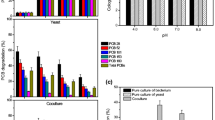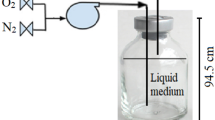Abstract
The effect of yeast extract and its less complex substituents on the rate of aerobic dechlorination of 2-chlorobenzoic acid (2-ClBzOH) and 2,5-dichlorobenzoic acid (2,5-Cl2BzOH) by Pseudomonas sp. CPE2 strain, and of 3-chlorobenzoic acid (3-ClBzOH), 4-chlorobenzoic acid (4-ClBzOH) and 3,4-dichlorobenzoic acid (3,4-Cl2BzOH) by Alcaligenes sp. CPE3 strain were investigated. Yeast extract at 50 mg/l increased the average dechlorination rate of 200 mg/l of 4-ClBzOH, 2,5-Cl2BzOH, 3,4-Cl2BzOH, 3-ClBzOH and 2-ClBzOH by about 75%, 70%, 55%, 7%, and 1%, respectively. However, in the presence of yeast extract the specific dechlorination activity of CPE2 and CPE3 cells (per unit biomass) was always lower than without yeast extract, although it increased significantly during the exponential growth phase. When a mixed vitamin solution or a mixed trace element solution was used instead of yeast extract the rate of 4-ClBzOH dechlorination increased by 30%–35%, whereas the rate of 2,5-Cl2BzOH and 3,4-Cl2BzOH dechlorination increased by only 2%–10%. The presence of vitamins or trace elements also resulted in a specific dechlorination activity that was generally higher than that observed for the same cells grown solely on chlorobenzoic acid. The results of this work indicate that yeast extract, a complex mixture of readily oxidizable carbon sources, vitamins, and trace elements, enhances the growth and the dechlorination activity of CPE2 and CPE3 cells, thus resulting in an overall increase in the rate of chlorobenzoic acid utilization and dechlorination.
Similar content being viewed by others
References
Adams RH, Huang CN, Higson FK, Brenner V, Focht DD (1992) Construction of a 3-chlorobiphenyl-utilizing recombinant from an intergeneric mating. Appl Environ Microbiol 58:647–654
Adriaens P, Kohler HPE, Kohler-Staub D, Focht DD (1989) Bacterial dehalogenation of chlorobenzoate and co-culture biodegradation of 4,4′-dichlorobiphenyl. Appl Environ Microbiol 55:887–892
Adriaens P, Focht DD (1990) Continuous coculture degradation of selected polychlorinated biphenyl congeners by acinetobacter spp. in an aerobic reactor system. Environ Sci Technol 24: 1042–1049
Bedard DL, Haberl ML (1990) Influence of chlorine substitution pattern on the degradation of polychlorinated biphenyls by eight bacterial strains. Microbial Ecol 20:87–102
Bioesen A, Arvin E, Broholom K (1993) Effect of mineral nutrients on the kinetics of methane utilization by methanotrophs. Biodegradation 4:163–170
Fava F, Marchetti L (1991) Degradation and mineralization of 3-chlorobiphenyl by a mixed aerobic bacterial culture. Appl Microbiol Biotechnol 36:240–245
Fava F, Di Gioia D, Marchetti L, Quattroni G, Marraffa V (1993) Aerobic mineralization of chlorobenzoates by a natural polychlorinated biphenyls degrading mixed bacterial culture. Appl Microbiol Biotechnol 40:541–548
Fava F, Di Gioia D, Cinti S, Marchetti L, Quattroni G (1994) Degradation and dechlorination of low-chlorinated biphenyls by a three-membered bacterial co-culture. Appl Microbiol Biotechnol 41:117–123
Harayama S, Kok M, Neidle EL (1992) Functional and evolutionary relationships among diverse oxygenases. Annu Rev Microbiol 46:565–601
Havel J, Reineke W (1991) Total degradation of various chlorobiphenyls by coculture and in vivo constructed hybrid pseudomonas. FEMS Microbiol Lett 78:163–170
Havel J, Reineke W (1993) Degradation of Aroclor 1221 in soil by a hybrid pseudomonad. FEMS Microbiol Lett 108:211–218
Henry SM, Grbic-Galic D (1990) Effect of mineral media on trichloroethylene oxidation by aquifer methanotrophs. Microb Ecol 20:151–169
Hernandez BS, Higson FK, Kondrat R, Focht DD (1991) Metabolism of and inhibition by chlorobenzoates in Pseudomonas putida P111. Appl Environ Microbiol 57:3361–3366
Hickey WJ, Focht DD (1990) Degradation of mono-, di-, and trihalogenated benzoic acids by Pseudomonas aeruginosa JB2. Appl Environ Microbiol 56:3842–3850
Hooper SW, Pettigrew CA, Sayler GS (1990) Ecological fate, effects and prospects for the elimination of the environmental polychlorinated biphenyls (PCBs). Environ Toxical Chem 9:655–663
La Pat-Polasko LT, McCarty PL, Zehnder AJB (1984) Secondary substrate utilization of methylene chloride by an isolated strain of Pseudomonas sp. Appl Environ Microbiol 47:825–830
Mason JR, Cammack R (1992) The eletron-transport proteins of hydroxylating bacterial dioxygenases. Annu Rev Microbiol 46:277–305
Miguez CB, Greer CW, Ingram JM (1990) Degradation of mono-and dichlorobenzoic acid isomers by two natural isolates of Alcaligenes denitrificans. Arch Microbiol 154:139–143
Nakatsu CH, Wyndham RC (1993) Cloning and expression of the transposable chlorobenzoate-3,4-dioxygenase genes of Alcaligenes sp. strain BR60. Appl Environ Microbiol 59:3625–3633
Papanastasiou AC, Maier WJ (1982) Kinetics of biodegradation of 2,4-dichlorophenoxy-acetate in the presence of glucose. Biotechnol Bioeng 24:2001–2011
Pettigrew CA, Breen A, Corcoran C, Sayler GS (1990) Chlorinated biphenyl mineralization by individual populations and consortia of freshwater bacteria. Appl Environ Microbiol 56:2036–2045
Reber HH, Kaiser P (1981) Regulation of the utilization of glucose and aromatic substrates in four strains of Pseudomonas putida. Arch Microbiol 130:243–247
Schmidt SK, Scow KM, Alexander M (1987) Kinetics of p-nitrophenol mineralization by a Pseudomonas sp.: effects of second substrates. Appl Environ Microbiol 53:2617–2623
Singleton P, Sainsbury D (1987) Dictionary of microbiology and molecular biology, 2nd ed. Wiley, New York, p 964
Sondossi M., Sylvestre M, Ahmad D (1992) Effects of chlorobenzoate transformation on the Pseudomonas testosteroni biphenyl and chlorobiphenyl degradation pathway. Appl Environ Microbiol 58:485–495
Sylvestre M, Massé R, Ayotte C, Messier F, Fauteux J (1985) Total biodegradation of 4-chlorobiphenyl by a two membered bacterial culture. Appl Microbiol Biotechnol 21:192–195
Tatara GM, Dybas MJ, Criddle CS (1993) Effects of medium and trace metals on kinetics of carbon tetrachloride transformation of Pseudomonas sp. strain KC. Appl Environ Microbiol 59:2126–2131
Wijngaard A van den, Van Der Kleij RG, Doornweerd RE, Janssen DB (1993a) Influence of organic nutrients and cocultures on the competitive behavior of 1,2-dichloroethane-degrading bacteria. Appl Environ Microbiol 59:3400–3405
Wijngaard A van den, Wind RD, Janssen DB (1993b) Kinetics of bacterial growth on chlorinated aliphatic compounds. Appl Environ Microbiol 59:2041–2048
Author information
Authors and Affiliations
Rights and permissions
About this article
Cite this article
Fava, F., Armenante, P.M., Kafkewitz, D. et al. Influence of organic and inorganic growth supplements on the aerobic biodegradation of chlorobenzoic acids. Appl Microbiol Biotechnol 43, 171–177 (1995). https://doi.org/10.1007/BF00170640
Received:
Revised:
Accepted:
Issue Date:
DOI: https://doi.org/10.1007/BF00170640




